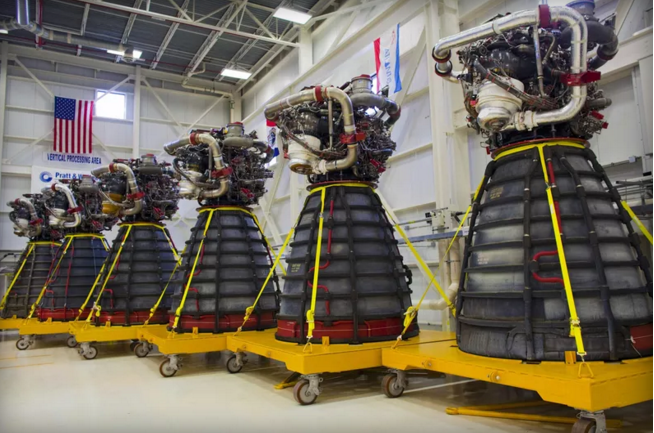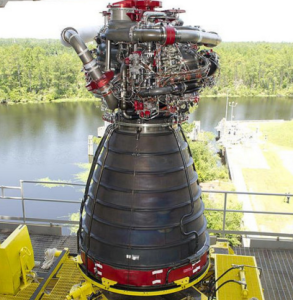Aerojet Rocketdyne has a long history with NASA. The aerospace and defense company has been supplying the agency with engines and rocket launchers since the early days of space travel; Aerojet’s RS-25 engine has the proud distinction of having been used to power all 135 Space Shuttle flights since its first mission in 1981. The RS-25, also known as the Space Shuttle Main Engine, may soon acquire a new title: the Space Launch System Engine. NASA’s new mission, which ultimately should bring humans to Mars, is well underway, and they’ve just awarded Aerojet Rocketdyne a $1.6 billion contract to continue to supply them with a steady stream of RS-25 launchers for the next decade.
The Space Launch System (SLS) is the next step up from the Space Shuttle, and it’s been given an impressive list of missions for the next two decades. It will take humans deeper into space than they’ve ever been before, with an ultimate goal of bringing a crew to the surface of Mars sometime in the 2030s. An Orion crew capsule is expected to be launched into lunar orbit in 2020. Needless to say, the SLS is going to need a lot of engines, and so the reliable RS-25 was the obvious choice.
 Modifications would need to be made, however. The SLS will experience colder temperatures, higher speeds and greater pressures than the Space Shuttle, so Aerojet is making some changes to the RS-25. Modifications have already been made to the 16 engines in NASA’s possession. The engines’ power has been upgraded from 491,000 pounds to 512,000 pounds of vacuum thrust, hugely boosting the amount of weight that can be lifted into the atmosphere. The new, sleeker engines, which Aerojet will be building for future SLS missions, will be more affordable and will require fewer parts and welds than the older ones, thanks in part to state-of-the-art manufacturing technologies including five-axis milling machines, digital X-rays… and, of course, 3D printing.
Modifications would need to be made, however. The SLS will experience colder temperatures, higher speeds and greater pressures than the Space Shuttle, so Aerojet is making some changes to the RS-25. Modifications have already been made to the 16 engines in NASA’s possession. The engines’ power has been upgraded from 491,000 pounds to 512,000 pounds of vacuum thrust, hugely boosting the amount of weight that can be lifted into the atmosphere. The new, sleeker engines, which Aerojet will be building for future SLS missions, will be more affordable and will require fewer parts and welds than the older ones, thanks in part to state-of-the-art manufacturing technologies including five-axis milling machines, digital X-rays… and, of course, 3D printing.
 NASA has been testing a number of 3D printed engine components lately with the help of Aerojet Rocketdyne, and the RS-25 engines were hot-fired this past May. The 16 upgraded engines, which are currently being stored at NASA’s Stennis Space Center, will be used for the first four SLS missions, including the first two critical test flights known as Exploration Mission-1 and Exploration Mission-2. The agency is going to need a lot more than 16 engines in the future, however; unlike the Space Shuttle, the SLS rocket launchers will not be recovered after each launch, so a new engine will need to be built each time. That’s great news for Aerojet Rocketdyne, which is now under contract with NASA until 2024. The $1.6 billion contract will give the company plenty of money to supply new and improved engines for the next decade.
NASA has been testing a number of 3D printed engine components lately with the help of Aerojet Rocketdyne, and the RS-25 engines were hot-fired this past May. The 16 upgraded engines, which are currently being stored at NASA’s Stennis Space Center, will be used for the first four SLS missions, including the first two critical test flights known as Exploration Mission-1 and Exploration Mission-2. The agency is going to need a lot more than 16 engines in the future, however; unlike the Space Shuttle, the SLS rocket launchers will not be recovered after each launch, so a new engine will need to be built each time. That’s great news for Aerojet Rocketdyne, which is now under contract with NASA until 2024. The $1.6 billion contract will give the company plenty of money to supply new and improved engines for the next decade.
There’s still a long road ahead. The first SLS has not yet been built, and its first test flight is not scheduled until 2018. NASA has not yet made any official bulk orders for the RS-25 engines, but the contract includes one order, and the plans for the SLS indicate that there will be many more in the future. It’ll be a while before we can finally see, firsthand, if there is life on Mars, but we’re closer now than we’ve ever been before.
Subscribe to Our Email Newsletter
Stay up-to-date on all the latest news from the 3D printing industry and receive information and offers from third party vendors.
Print Services
Upload your 3D Models and get them printed quickly and efficiently.
You May Also Like
Consolidation in AM: How 2025 Is Shaping the Industry’s New Normal
The first half of 2025 has been marked by a clear shift in the additive manufacturing (AM) industry. Companies are no longer just focused on developing new tech by themselves....
Etsy Design Rule Change Reduces Selection of 3D Printed Goods
Online marketplace Etsy has implemented a rule change requiring all 3D printed goods on the site to be original designs. The update to the site’s Creativity Standards states, ¨Items produced using...
U.S. Congress Calls Out 3D Printing in Proposal for Commercial Reserve Manufacturing Network
Last week, the U.S. House of Representatives’ Appropriations Committee moved the FY 2026 defense bill forward to the House floor. Included in the legislation is a $131 million proposal for...
Transforming From Tourist to Native: Duro CEO Michael Corr Explains Why the Company Rebuilt its PLM Software on AI
In these early innings of the AI boom, many market analysts have expressed concern that AI spend has gotten too far ahead of the technology’s proven ability to deliver significant...


































